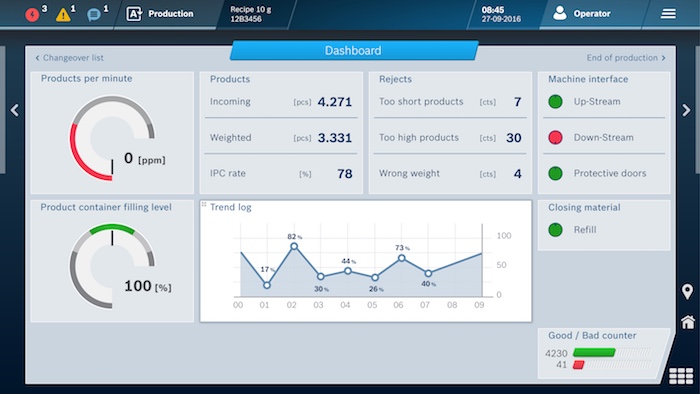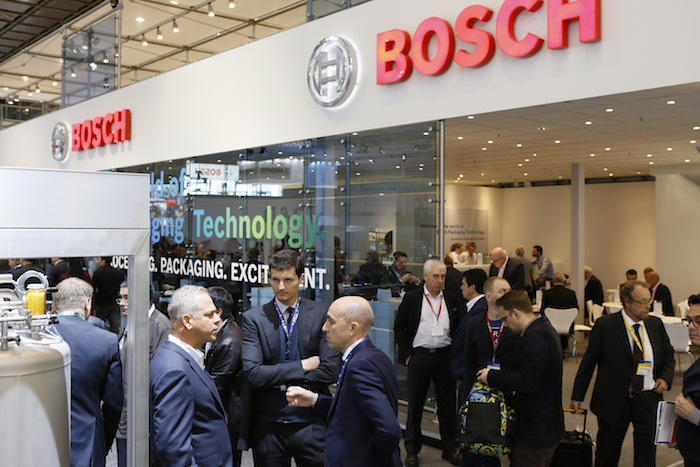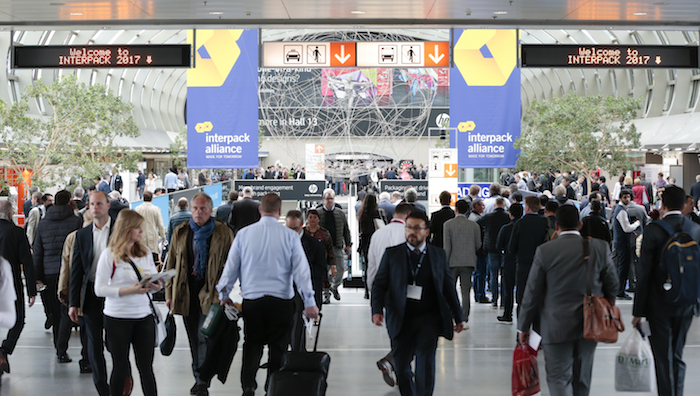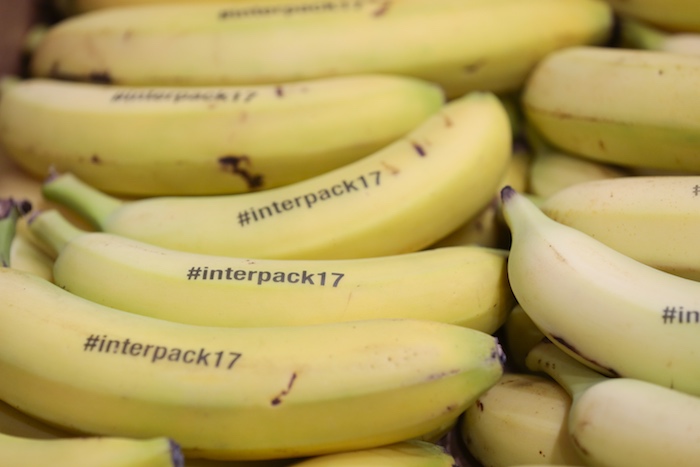The digital transformation towards networked production environments in terms of Industry 4.0 (I4.0) and/or the Internet of Things (IoT) is gaining momentum. Numerous applications from the areas of product and process monitoring, labelling technology, packaging, logistics as well as maintenance and repair show already today the optimisation potential that this transformation to the Internet of Things holds.
Author: Hans Peter Fritsche, freelance trade journalist, Redaktionsbüro H. Fritsche
Concrete Benefits for Industrial Value Chains
These “things” are sensors, RFID chips (Radio Frequency Identification), devices, machines and plants. In future, these “things” are not only expected to deliver information on all important process and system conditions independently and continuously but they are also expected to communicate with each other via the Internet and intervene in manufacturing processes to correct and optimise them without human intervention. The basis for this web-based communication is the Internet Protocol (IP) with its unique-identifier IP addresses. The old Internet Protocol IPv4, however, was only capable of delivering an address space of just under 4.3 billion IP-addresses – and these had already all been allocated as early as 2012 – to PCs, notebooks, tablet-PCs and mobile phones. This is why the new standard IPv6 was developed which has an address space of 3.4 x 1038 IP addresses. So a lack of addresses is no longer a worry. The changeover to IPv6 is still in full swing. So the challenges are not so much the things as such and their addresses but rather the flood of data they cause when one fine day billions of sensors will be transmitting thousands of data per second to host computers. This data then has to be evaluated for visualisations and simulations and to be saved for documentation purposes (traceability).
So the Internet of Things is primarily about data; about the information retrieved from this data – to be precise. And this is the domain of software and algorithms. What can be achieved with this alone should be reason enough to actively drive this transformation. The following examples show applications that pay off in the short term.
Paradigm Change in Maintenance
Damaged bearings, transmissions, pumps or filling and dosing systems do not occur out of the blue but “give notice” long before the damage actually occurs by unusual vibration and temperature deviations or by changed power consumption, a loss of pressure and the like. These deviations detected by sensors as part of condition monitoring can today be evaluated and visualised in real time thanks to highly complex analysis and simulation programmes and therefore be seen in the process engineering context. On the basis of this information machine and plant operators can intervene in the system by remote control in a targeted manner and above all location-independently with a view to always running systems in the optimum mode, to introducing programme changes or to installing new applications and control software. Furthermore, simulation results permit precise forecasts regarding the remaining service life of critical machine parts, which opens up completely new perspectives for maintenance.

This means we are moving away from the reactive as well as preventive maintenance with its cycle-based component replacement intervals and towards predictable, precisely plannable maintenance measures – to so-called “predictive maintenance”. The benefits are a higher machine and plant availability, substantially reduced downtime risks, higher operational and production safety as well as considerably lower maintenance costs.
Beyond this, predictive maintenance is a key element in sustainability. It is true that operators always played it safe when replacing components at set intervals but they also wasted valuable remaining service life of expensive components because they lacked reliable part behaviour data. Today, the knowledge about material behaviour, continuous stress under alternating loads and the like is far more advanced than 10 or even 20 years ago. Another aspect is the significantly higher computing performance available today as well as smarter analysis, FEM (Finite Element Method) and simulation software. They allow the remaining service life to be determined and predicted with a high degree of precision – and this knowledge benefits predictive maintenance.
Chatting with Machines
The increasing performance, flexibility and intelligence of machines and plants results in ever more complex systems posing the greatest of challenges for the developers of concepts for operating human-machine interfaces (HMI). By HMI hardware we mean terminal devices with touch-screen functionalities that most people know from their smartphones or tablet PCs. This means they can build on existing knowledge for learning to handle these machines and plants – this motivates and definitely shortens familiarisation time.
One central aspect in the development of graphical user interfaces is to ensure that these machines can also be safely operated by people without specific vocational training and often also without sufficient language skills. To avoid operating errors the developers of GUIs rely on intuitive graphical elements instead of language. Also up and coming are photo-realistic 3D CAD displays of machines, plants and components. Furthermore, HMIs have to live up to the needs of various users – in line with their skills and authorities. Therefore, machine operators see different graphical user interfaces to shift managers, maintenance staff or production managers. This means, every user only sees the data that corresponds to their area of responsibility and is of relevance to their specific situation. Furthermore, the data is limited to the essentials; this ensures an easy-to-grasp display and an instant presentation of the key machine parameters and production data.

Other characteristics of modern HMIs are mobility and consistency. There is a trend towards mobile devices with which the user can control machines and equipment remotely depending on their authority level. This saves time and travel expenses especially in the field of service and maintenance.
Working in Virtual Worlds
When it comes to the Internet of Things, there is hardly a topic that currently causes as much a stir as virtual, or rather digital twins. The technical basis for virtual twins are high-performance 3D CAD, simulation and analysis software programmes as well as virtual 1:1 copies of real machine and equipment control software. Based on such software tools digital twins map the complete manufacturing process including components, machines, plants and their controls as a virtual model – complete with all the physical data required for the simulation. In addition to this, digital twins permit offline programming. All of this makes virtual twins universal tools for developers, operators and maintenance staff.
Thanks to these near-reality simulations design errors and/or weak spots can already be detected and eliminated in the development stage without having manufactured a single real part beforehand. This also applies to the programming and optimising of controls.

One of the most important applications, however, is virtual commissioning or start-up. This is not only a virtual trial run but also serves to familiarise the operator in charge of the machine with the properties and possibilities of the system in a targeted manner. In other words: the digital twin is the “flight simulator” for industrial processes, machinery and equipment. The virtual pre-start up before the real commissioning pays off in more ways than one. Should there still be any bugs in the system or control concept, they can be remedied without causing damage to real system components. Offline programming, in turn, allows production planners to virtually test various operating modes. The most important aspect, however, is that the virtual twin brings together the expertise of many specialists, which can later also be used for other projects.
In a nutshell: thanks to the sophisticated simulations plant manufacturers and users can achieve significantly shorter project leadtimes, faster start-ups and marked efficiencies for the development of similar plants and processes. This saves time but above all resources, energy and manpower.
Standardised Interfaces a Must
Standardisation continues to be a major challenge because most machinery producers still rely on their own interfaces. However, integration is the decisive feature in the Internet of Things. This integration requires especially consistent data and information exchange between machines – both vertically and horizontally. And this makes open standard protocols necessary. Therefore, there is a trend towards Open Source solutions since these offer high security of investment and independence being non-proprietary systems. One example is the OPC Unified Architecture (OPC UA), a package of specifications for linking machines of various manufacturers. OPC UA ensures security through authentication and authorisation, encryption and data integrity.
This means OPC UA is ideally suited for a safe, reliable and non-proprietary transport of raw data and pre-processed information from the manufacturing level to superior production planning or ERP systems.
Even Old Systems can Handle 4.0
Many older machines, lines, motors and compressors are not equipped with the sensors and communication technology for Industry 4.0 – sometimes not even for operation as part of networked systems. This does not mean that these systems are obsolete in view of digital transformation. Here – as an entry-level solution for Industry 4.0 – smart sensors can be retrofitted. They regularly measure important condition parameters of the machines and systems and transmit the data via built-in communication interfaces wirelessly to the HMIs and/or employees’ smartphones or tablet PCs for evaluation. With these and other simple methods companies can enter the world of Industry 4.0 inexpensively and still benefit from reduced downtimes, longer machine uptimes as well as lower power consumption and the like.
At interpack 2017, the VDMA Food Processing and Packaging Machinery Association is organizing a special exhibition on the topic of Industry 4.0. It will take the form of a Technology Lounge at the VDMA stand, featuring examples of solutions in packaging machinery and process engineering and opening up new opportunities for applications in security, traceability, copying and counterfeit protection as well as in customised packaging. More information under http://nuv.vdma.org/interpack.




